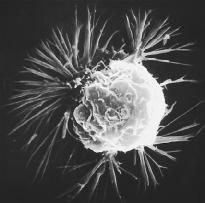Breast Cancer - Treatment
The treatment used for breast cancer depends on how serious a patient's condition is. Under the best circumstances, the cancer is found at an early stage. It may consist of nothing more than a small lump in the breast. In other cases, it may have developed into a larger lump or begun to metastasize.
The simplest treatment is a lumpectomy, a procedure in which the cancerous lump is removed from the breast. The surgeon also removes some tissue around the lump and some of the lymph nodes under the arm. Removing healthy tissue around the lump ensures that all of the cancer has been removed. Removing the lymph nodes allows the doctor to test for metastasis.
A more serious form of treatment is a mastectomy (pronounced mas-TEK-tuh-mee). A mastectomy may be required if a lump has become quite large or the cancer has spread to the chest muscles. In a mastectomy, the patient's entire breast is removed. In the most extreme conditions, the surgeon may also remove the chest muscles around the breast and all the lymph nodes under the arm. This procedure is called a radical mastectomy. Radical mastectomies are rarely done.
Some women also choose to have reconstructive surgery. In reconstructive surgery, an artificial breast is created to replace the breast removed during a mastectomy. The artificial breast may provide a women with a better sense of self-esteem by restoring her natural shape.
If cancer cells are found in the lymph nodes, more aggressive treatment may be necessary. The presence of these cells suggests that the cancer has begun to spread to other parts of the body. Additional treatments are then needed to kill cancer cells in all parts of the body. Such forms of treatment are known as systemic (for "system") treatments.

Three common forms of systemic treatment include radiation, chemotherapy, and hormone therapy. In radiation treatments, some form of radiation is used to kill any remaining cancer cells in the breast or other parts of the body. The radiation used is similar to X rays, but much more powerful.
Chemotherapy involves the use of certain chemicals known to kill cancer cells. These chemicals are given to the patient either by injection or by mouth. They travel through the body and kill cancer cells wherever they are found. Both radiation and chemotherapy have some serious side effects, including nausea and vomiting, temporary hair loss, mouth or vaginal sores, fatigue, and infertility.
Hormone therapy is a special type of chemotherapy. In one form, it makes use of a natural product known as tamoxifen (pronounced tuh-MOK-sih-fen) to kill cancer cells. Patients take one pill a day for at least two years and sometimes as long as five. Studies show that the use of tamoxifen can lower the chance that breast cancer can return by between 25 and 35 percent.

Comment about this article, ask questions, or add new information about this topic: